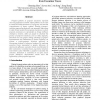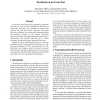146 search results - page 16 / 30 » Sequential Traitor Tracing |
ICTAI
2008
IEEE
14 years 3 months ago
2008
IEEE
Frequent patterns in program executions represent recurring sequences of events. These patterns can be used to reveal the hidden structures of a program, and ease the comprehensio...
LICS
2003
IEEE
14 years 2 months ago
2003
IEEE
Given a regular collection of Mazurkiewicz traces, which can be seen as the behaviours of a finite-state concurrent system, one can associate with it a canonical regular event st...
APLAS
2010
ACM
13 years 7 months ago
2010
ACM
Live heap space analyses have so far been concerned with the standard sequential programming model. However, that model is not very well suited for embedded real-time systems, wher...
RELMICS
2009
Springer
14 years 1 months ago
2009
Springer
Abstract. A Concurrent Kleene Algebra offers two composition operators, one that stands for sequential execution and the other for concurrent n [10]. In this paper we investigate ...
ISCA
2003
IEEE
14 years 2 months ago
2003
IEEE
As processor back-ends get more aggressive, front-ends will have to scale as well. Although the back-ends of superscalar processors have continued to become more parallel, the fro...


